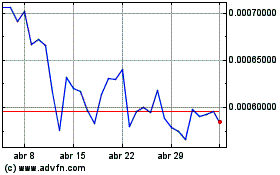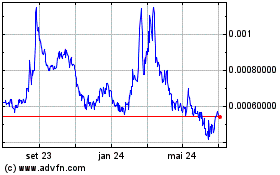Future of Content: How Web 3.0 Revolutionizes Approach to the Creator Economy
12 Agosto 2022 - 2:14AM
NEWSBTC
More than 50 million people worldwide consider themselves to be
creators of some kind of content. The content creator economy is a
fast-evolving market niche that is experiencing exponential growth.
Its current size is estimated to be a little over $100 billion,
showing an 8-fold increase year-on-year. This new economic sector
requires new approaches and instruments, as large corporate
platforms exercise great power over the creators’ content, and
personal websites and blogs have limited reach. The problem with
Web 2.0 In the current state of the Internet, known as Web 2.0,
content is stored on a particular server or computer and accessed
via a web address known as a URL, or Uniform Resource Locator, that
specifies its location on a computer network and a mechanism for
retrieving it. This means that the owner of the computer or the
server where content is stored has complete control over whether
and how it can be accessed and can limit access or even delete
content at any time. At present, if the creators of video content,
photographs, or blogs want to get their material out into the
world, they have little choice but to post it on major social
network platforms like Alphabet’s YouTube, Meta’s Facebook and
Instagram, TikTok, Pinterest, Tumblr, Snapchat, and the like. While
this provides access to huge audiences, this benefit comes with
major drawbacks. This is because all content is stored and hosted
on these Big Tech companies’ central servers, which these corporate
behemoths have complete control of, and creators must give up a
great deal of power over their content to put it there. At any time
and at their own discretion, these social media giants can block
any content they dislike or deprive creators of the ability to earn
money from it. The platform has no legal obligations to the
creators, so creators have no right to claim damages. All revenue
generated by the creators’ content is collected and distributed by
the network, and creators have no say as to what share they will
receive. This disparity in terms of power and revenue puts content
creators at a great disadvantage. Could Web 3.0 be the answer? The
answer to this conundrum may be the third iteration of the
internet: Web 3.0 Web 3.0 represents a whole new stage of
development for the internet, in which working with web content
will be organized in a completely different way. It is based on
decentralizing content by storing data not on just one central
server, but distributing it among many computers, or nodes, in a
P2P (peer-to-peer) network with the help of blockchain technology.
In this way, content is no longer held hostage in large corporate
data centers, and big corporations and government authorities lose
their ability to dictate if or how it can be used. Web 3.0
technologically eliminates the monopoly of Web 2.0 platforms and
returns ownership of content to the creators themselves. This will
fundamentally change the way creators produce and manage their
content while providing them with better opportunities to profit
from their work. Moving into the future While Web 2.0 platforms
have demonstrated their commercial value, their drawbacks are
becoming increasingly apparent. Delivering content through Web
3.0-based platforms can be the ideal answer to the problems
creators currently face when dealing with faceless corporations.
This is particularly true for creators of video content, whose work
may be arbitrarily censored, restricted, or demonetized. One such
solution is a new application called FavorTube, which is a Web 3.0
media-streaming platform offering real-time, consumer-grade HD
video playback and full lifecycle services for content creation. It
connects content creators, consumers, and fans in one decentralized
platform that is transparent, fair, and anti-censorship, where all
users benefit. With FavorTube, content creators produce and upload
videos and earn revenue when consumers subscribe to their channels
or content. Revenue from consumer views of ads on the platform is
automatically distributed among creators, the platform, and viewers
via smart contracts. Multiple forms of NFTs (permanent membership,
crowdfunding) can be issued with one click, and revenue from
channels or content is automatically distributed to NTF holders.
Access to content is authorized on the P2P network, which protects
the rights and interests of commercial videos. Randomly assigned
DAO (decentralized autonomous organization) auditors from the
FavorTube community monitor content and can ban material deemed to
be inappropriate. FavorTube uses its own protocol stack, dubbed
FavorX, as decentralized storage and content distribution
underlayer. While some projects have already carried out
theoretical exploration and technological R&D in this area,
FavorTube is the first media-streaming platform to implement
complete decentralization for file storage, content distribution,
data retrieval, and purchase transactions. Its out-of-the-box
desktop and mobile applications are directly connected to the
blockchain on mobile terminals via P2P networks whose performance
increases as the scale of the network expands. FavorTube is also
the first fully decentralized application project to support the
use of mobile terminals directly connected without gateways on an
anti-censorship and globally accessible streaming platform.
FavorTube takes the underlying concepts of similar Web 2.0
platforms but discards the monopolistic practices they use to
generate excess profits, thus creating a new business model for
content creation and revenue distribution by harnessing the
decentralized financial characteristics of blockchain. Its
decentralized storage and content distribution capabilities turn
the power relationship between content creators, consumers, and
content display platforms on its head to implement the fundamental
idea behind Web 3.0 – that data is owned by users This represents a
multi-dimensional leap over existing Web 2.0 content creation
platforms, from the technical foundation to the business model, and
provides content creators and consumers with an anti-censorship,
high-yield, and autonomously growing application platform, which
will be the first blockchain application project to exploit the
commercial value of Web 3.0. As Web 3.0 develops, there is no doubt
that other projects will emerge and follow in the footsteps of this
ground-breaking project, as content creators increasingly seek out
new platforms where they can display and profit from their work
freely and fairly, without the ever-present oversight of Big
Brother corporations.
OMI Token (COIN:OMIUSD)
Gráfico Histórico do Ativo
De Abr 2024 até Mai 2024

OMI Token (COIN:OMIUSD)
Gráfico Histórico do Ativo
De Mai 2023 até Mai 2024
